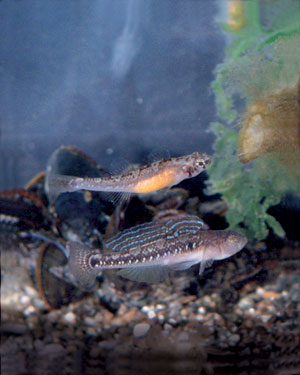Not so lady-like?
At first she is shy and reserved, just like a nice girl ought to be. Then she is transformed into a macho chick.
The two-spotted goby is a tiny creature that lives in shallow waters along the Norwegian coast. It is probably Norway’s most common shallow water fish, and plays an important role in the coastal ecosystem, eating tiny crustaceans and in turn being eaten by young cod. The twospotted goby is just 4 to 5 cm long, but both the male and female are beautifully coloured – a feature that can be somewhat uncommon in the animal kingdom. The male has bright blue stripes on its fins, while the female has an equally bright orange belly.
For years, researcher Elisabet Forsgren has kept her feet on the ground, studying the tiny gobies, while one of her colleagues, Prof. Trond Amundsen, has had his head in the clouds, studying birds’ mating behaviour. But when the two got together on a collaborative project, they discovered some surprising things about the two-spotted goby’s sex life.
REVERSED SEX ROLES
The two-spotted goby lives for only one year, but can spawn 5 or 6 times during the mating season, from May to July. In the beginning, everything pretty much follows the norm: The male shows off, flirts and tries to look tough, fights off rivals and does more or less whatever it takes to mate. The female watches demurely, but can be persuaded to mate by an extra-attentive male.
But halfway through the season, everything turns up side down. Suddenly, the female is the aggressive one. She flirts and tries to look good – while the male becomes passive.
There are species where sex roles are constantly reversed. But this kind of somersault in the middle of the breeding season is extremely rare; in fact, this kind of role reversal midway though the breeding season has never before been seen in vertebrates. So why should it happen with two-spotted gobies? The short answer is: nobody really knows for certain.
However, researchers are happy to speculate. “We believe it has something to do with the gradual disappearance of males during the course of the breeding season,” Forsgren and Amundsen said. “Males might quite simply die off from all the hard work. Not only do the males have to fight for females again and again; they also have several broods of eggs to take care of – which is a job that male two-spotted gobies assume. It’s possible that all their fighting, flirting and parental duties simply kills them. Whatever the cause, we have found that there are very few males around by the mating season’s end. Those who are still around are surrounded by great numbers of females – who in turn behave like the most aggressive macho males in order to produce yet another brood of eggs.We think the females are driven by pure desperation.”
ORANGE FEMALES GET THE FIRST DANCE
It’s highly uncommon to find species where both the male and the female are colourful. In the animal kingdom, colours and finery are usually reserved for the male, while the female blends in with the background. This makes sense when sex roles are based on competitive males and choosy females.
However, there are a few species where the female is bright and the male is dull. In those cases the sex roles are usually reversed, and the females flirt and compete with each other while the males pick and choose.
But it is rare that both males and females are extravagantly – and differentially — coloured. Researchers have previously assumed that female finery was simply a side effect of male evolution, and without any real significance.
Before Forsgren and Amundsen’s work on the two-spotted goby, nobody had studied species where the female is attractive in her own way and sex roles are not permanently reversed.
“The theory that female attractiveness is simply a side effect of male evolution is simply not applicable in these cases,” the research team points out.
The two biologists first believed that the sex roles were traditional in the two-spotted goby, and they didn’t understand why the female had such a lovely, orange belly. They soon realized that some of the females were more orange than others and wanted to find out whether males preferred more highly coloured females.
That turned out to be the case. The males went straight for the females with the brightest colours. As much as 80 per cent of the flirtation was targeted at the most colourful females. The same thing happened when the researchers picked out two pale females and coloured the belly of one bright yellow while the other was treated with uncoloured Indian ink. The yellow female was immediately asked to dance, while the other remained a wallflower.
“The females’ glowing colours must have developed for the benefit of the female, perhaps to attract males,” the two researchers conclude.
NEW PERSPECTIVES
Åsa Borg and Jens Bjelvenmark are research fellows who have also participated in the research on the tiny two-spotted goby. Results from the study have attracted major international scientific and media attention. The research team is continuing with new studies of the two-spotted goby’s peculiar sexual life.
”There are still many unanswered questions related to the females.We would like to find out whether there is a connection between colour and quality. It appears that the females with the most orange colouring lay their eggs sooner than the others, but we don’t know if they produce better offspring,” the researchers explain.
They would also like to look more closely at the dynamic sex roles in the fish, to understand the mechanisms behind the sudden somersault. Why do the roles reverse at that precise moment? Is it hormonally connected? And what happens to the males? Do they die, and if so,why?
“The two-spotted goby turned out to be a lot more complex and interesting than we could have possibly imagined. Its situation might apply to other species as well, which opens the door for new and exciting perspectives of sex roles in the animal kingdom,” Forsgren and Amundsen conclude.
By Lisa Olstad





